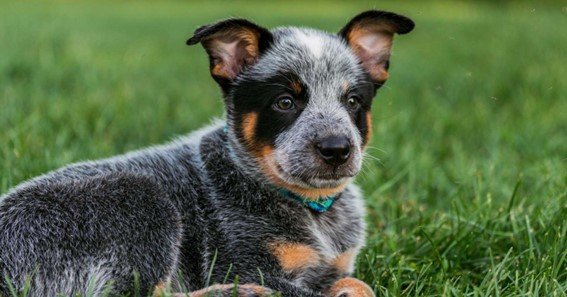What type of dog is Bluey? Bluey is a Blue Heeler, also known as an Australian Cattle Dog. Bluey is a popular Australian kids’ TV show character. She is a Blue Heeler or Australian Cattle Dog. This breed is intelligent, swift, and loyal, ideal for Bluey and her busy family.
Bluey’s personality reflects the breed’s busyness, intelligence, and family loyalty. Knowing Bluey’s breed makes us respect her and the intriguing breed she represents. In this article, we discuss about what type of dog is bluey and more about it.
What Type Of Dog Is Bluey?
Bluey is a Blue Heeler, also known as an Australian Cattle Dog. Bluey and her family are Australian Blue Heelers. Blue Heelers, or Australian Cattle Dogs, are intelligent, active, and good herders. Australian settlers bred them to work cattle on vast ranches in the 1800s. Their keen, attentive visage and blue-gray hair make them simple to distinguish.
People appreciate Blue Heelers because they work hard and are loyal. Bluey’s portrayal of these attributes makes the show enjoyable and a subtle reference to the breed’s greatness.
All About Blue Heelers: The Breed Behind Bluey
Blue Heeler dogs, which gave us Bluey, are exciting and unique. Knowing about these magnificent canines’ backgrounds, traits, and care needs completes their image. Just know this about Blue Heelers.
-
History of the Blue Heeler
In the 1800s, Australian settlers bred the Blue Heeler to handle tough livestock herding on large ranches. Breeders combined domestic herding dogs with wild Dingoes to develop a canine with the stamina to move cattle great distances. Hardworking Blue Heelers have long helped Australia’s cattle industry.
-
Physical Characteristics
Blue Heelers are medium-sized, strong dogs with blue-gray bodies and unique spots or mottling. They look alert with straight ears. Weight ranges from 35 to 50 pounds for men and slightly less for women.
They can work in variable weather because their coat doesn’t get wet. As herding dogs, the breed’s athletic build and strong muscles demonstrate agility and stamina.
-
Temperament and Personality
Intelligent and loyal, Blue Heelers are active and need lots of mental and physical exercise. Some call them “velcro dogs” because they want to be close to their owners.
Even though they’re wary of strangers, early socialization makes them good pets. Because they are defensive, they make good watchdogs because they continually look for threats.
-
Training and Obedience
Intelligent and eager to please, these dogs are easy to train. They excel in obedience, agility, and herding. Start training early and use positive reinforcement to stay motivated.
Blue Heelers ‘ favorites are brain and body stimulation and learning new commands and tricks. If you give them enough schooling and stimulation, they can get bored and do good things.
-
Exercise Needs
To stay healthy and happy, Blue Heelers need to run a lot. To keep youngsters from acting out or getting bored, they must go on walks, play, and think about different things daily. These dogs do best with active families that offer them the mental and physical activity they need.
Outdoor activities like hiking, running, and dog sports are fantastic ways to keep a Blue Heeler busy. Because they have a lot of energy, they shouldn’t live a sedentary existence.
-
Health Concerns
Several genetic diseases, like hip dysplasia and progressive retinal atrophy, are more likely in Blue Heelers than in other dogs. Regular vet visits help detect these issues and act swiftly.
Responsible dog breeders will check for these issues, but buyers should know what to look for. A nutritious, well-balanced diet and frequent exercise also help kids stay healthy and happy.
-
Diet and Nutrition
For Blue Heelers to stay healthy and full of energy, they need to eat a balanced diet high in protein. Controlling your portions is also vital to steer away from obesity, which can make joint problems worse.
You can offer them high-quality store-bought dog food or a well-prepared homemade diet. Always have fresh water on hand, and only feed a few goodies to keep them from getting fat.
-
Grooming Requirements
Blue Heelers have short, dense coats that don’t need much care. Brushing them regularly removes stray hair and improves their coat.
They shed a little year-round but more during shedding seasons. Overbathing can ruin their coat of natural oils, so bathe as needed. Regular nail trimming, ear cleaning, and dental hygiene are also crucial for their well-being.
Conclusion
Bluey, the animated Blue Heeler, has won over audiences worldwide with her fun adventures and relatable family. Knowing the breed of dog behind the character makes me appreciate the show’s writers even more because they showed how intelligent, loyal, and active an Australian Cattle Dog is.
Whether you’re a fan of the show or considering a Blue Heeler as a pet, knowing about the breed’s history, characteristics, and care requirements is essential. Active families love Blue Heelers as working dogs and companions.
Their versatility and endearing qualities keep them famous on-screen and off-screen. In above we discuss what type of dog is bluey and explore more about it.
FAQ
What Type Of Dog Is Bluey?
Bluey is a Blue Heeler, or Australian Cattle Dog.
Are Blue Heelers Good Family Pets?
Blue Heelers are intelligent, loyal, and great with active families. Due to their protectiveness and loyalty to owners, they make great partners.
How Much Exercise Do Blue Heelers Need?
Blue Heelers need an hour of vigorous exercise daily. Because they have a lot of energy, running, climbing, and agility training are great for them.
What Are Common Health Issues In Blue Heelers?
Hip dysplasia and progressive retinal degeneration are two prevalent health concerns. Getting your pet to the vet often and living a healthy life can help you deal with these concerns.
Do Blue Heelers Shed A Lot?
Blue Heelers shed considerably and require regular brushing to control loose hair. When the seasons change, cats shed more, so they need to be groomed more often.
Sources:
https://www.dailypaws.com/living-with-pets/pet-compatibility/what-kind-of-dog-is-bluey
We have covered all the below topics in the above article










